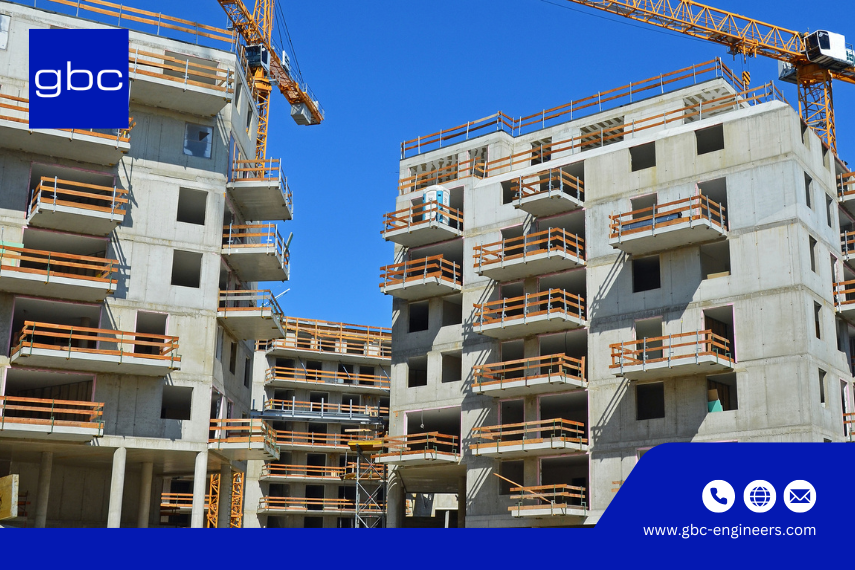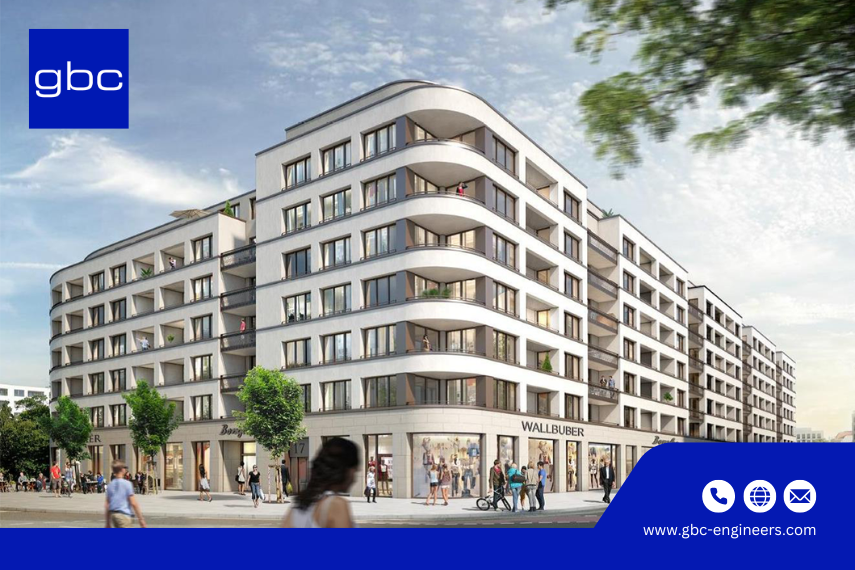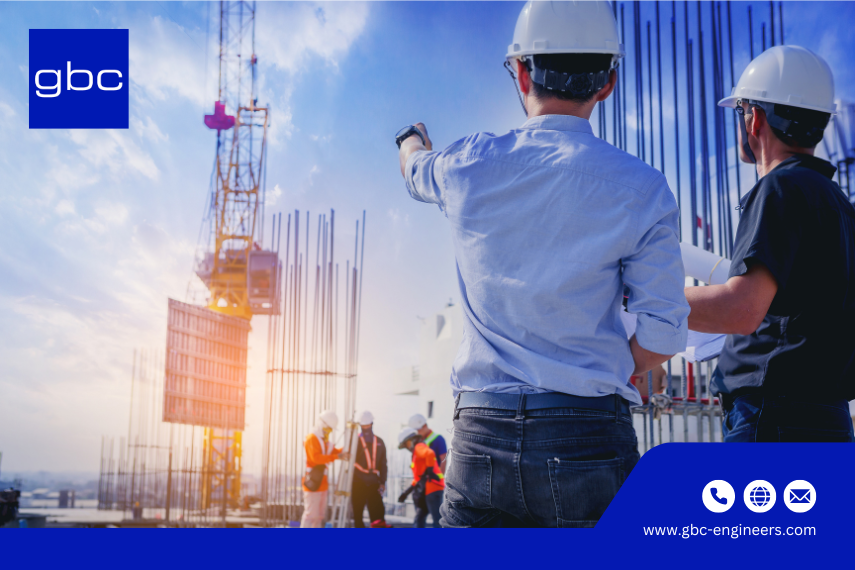Explore how gbc engineers optimize concrete and masonry structure design for sustainable, cost-efficient Civil & Residential developments.
Introduction
Across Europe, the demand for Civil & Residential projects that combine durability, sustainability, and construction efficiency continues to rise. As cities grow denser and environmental standards become stricter, developers and design teams are challenged to rethink traditional approaches to residential construction. The key question is how concrete and masonry systems can meet the structural, environmental, and cost expectations of modern urban housing.
Leveraging extensive experience in residential structural engineering, the team behind Civil & Residential projects has developed strategies that unite high-performance materials with advanced digital design methods. Through smart use of BIM coordination, structural optimization, and sustainable detailing, each project is tailored to achieve long-term reliability while minimizing environmental impact.
This approach has already proven effective in projects such as the Residential Complex Steimker Garten and various multi-storey apartment buildings designed with optimized concrete and masonry systems. By integrating engineering precision with sustainable thinking, these projects demonstrate how thoughtful structural design can shape the next generation of living spaces in Europe.

Industry Context: Trends and Challenges
The residential construction landscape is evolving rapidly under the combined influence of urbanization and sustainability requirements. As cities grow denser, multi-storey residential developments are becoming the new standard, demanding structures that balance strength, resource efficiency, and environmental responsibility. One key driver is the push for earthquake-resistant housing, ensuring safety while keeping costs under control. At the same time, the industry is shifting toward low-carbon materials and optimized construction systems that reduce environmental impact without compromising performance.
Key trends shaping modern residential design include:
- Increasing demand for earthquake-resistant structures that ensure long-term safety.
- A focus on material optimization and carbon reduction, using high-performance concrete and eco-friendly masonry systems.
- The integration of multi-storey building structural design in dense urban areas with limited construction space.
These shifts bring along new challenges. Designers must work within tight site constraints and complex geometries, finding structural solutions that remain buildable and compliant. They must also balance aesthetic and regulatory demands while reducing material use through innovative detailing and simulation tools.
Competitors across Europe are exploring similar challenges. Werner Sobek pioneers lightweight structures to reduce embodied carbon, while Bollinger+Grohmann focuses on integrated digital coordination between disciplines. In comparison, the Civil & Residential approach at gbc engineers integrates structural design, digital workflows, and sustainability-driven engineering within one collaborative framework.
Recent projects such as the Steimker Garten 4.0 and 4.1 and New Residential Complex Denickestraße, Harburg illustrate how this approach delivers tangible results: reduced concrete volumes, improved coordination through BIM, and faster construction timelines. This combination of digital precision and engineering insight is shaping the next generation of sustainable urban housing across Europe.
The Role of Concrete and Masonry in Modern Residential Design
Concrete and masonry remain the structural backbone of modern residential architecture, valued for their strength, longevity, and adaptability. These materials provide exceptional load-bearing capacity, fire resistance, and acoustic comfort, key qualities for creating safe and enduring homes. In today’s dense urban environments, their versatility enables engineers to design multi-storey buildings and complex housing developments that balance space efficiency, performance, and architectural freedom.
When combined intelligently, reinforced concrete frameworks and engineered masonry infills offer the ideal synergy between structural stability, constructability, and sustainability. This hybrid system not only supports architectural expression but also improves thermal efficiency and cost-effectiveness, factors essential to future-ready urban living.
Practical examples of this approach can be found in the New Residential and Commercial Building Dresden, where optimized concrete and masonry systems reduced reinforcement quantities, shortened construction timelines, and improved energy performance.
These outcomes are further strengthened through the company’s integrated BIM services and structural design expertise ensuring every connection, wall layout, and reinforcement detail is digitally coordinated and clash-free.
By merging material efficiency with digital precision, concrete and masonry continue to define the essence of modern Civil & Residential developments—structures that are safe, sustainable, and built to last.

Key Principles of Efficient Concrete & Masonry Structure Design
Efficiency in concrete and masonry design is achieved through a combination of technical precision, digital collaboration, and sustainability-oriented thinking. In modern Civil & Residential projects, these elements come together to ensure that every structure is strong, resource-efficient, and environmentally responsible.
Smart Material Selection and Structural Systems
The foundation of structural efficiency begins with material intelligence. Choosing high-performance concrete, low-carbon cement mixes, and engineered masonry units helps reduce embodied carbon while improving durability. Hybrid systems that combine reinforced concrete frames with load-bearing masonry walls enable design flexibility, construction speed, and cost efficiency.
This concept is clearly demonstrated in the Steimker Garten 4.0 and 4.1, where BIM-based simulations optimized reinforcement quantities and accelerated coordination. A similar strategy was applied in the Siemens Campus Erlangen, integrating concrete and masonry systems to meet complex architectural and energy-efficiency goals.
Seismic and Structural Safety (Earthquake-Resistant Design)
Seismic safety remains a defining factor in structural reliability. Through advanced reinforcement modeling, ductility control, and Eurocode-compliant simulations, structures can effectively absorb and dissipate seismic energy. This approach is rooted in performance-based engineering and continuous digital evaluation.
Insights from How Earthquake-Resistant Design Review Ensures Structural Safety demonstrate how modern analysis supports resilient and future-proof residential structures.
Construction Efficiency and Cost Optimization
Efficiency extends beyond design, it continues throughout construction. BIM-driven workflows, parametric modeling, and prefabricated masonry components reduce both cost and time. Early clash detection and coordination allow teams to resolve design-to-build issues before site execution.
As explored in Structural Engineering Quality: From Design Approval to Supervision, early-stage collaboration leads to smoother execution, faster delivery, and measurable cost savings across residential and mixed-use projects.
Sustainability and Environmental Responsibility
Every efficient structure must also be sustainable. Life-cycle assessment (LCA), low-carbon materials, and design-for-disassembly strategies now define responsible structural design. These considerations reduce embodied CO₂ and promote circular construction and supports smarter engineering decisions and long-term ecological goals.
Together, these principles define a forward-thinking approach to concrete and masonry structure design, one that merges performance, economy, and sustainability to build stronger, smarter, and greener living environments for the future.
Case Study: Sustainable Structural Design in Action
A recent residential development in Germany illustrates how sustainable design principles can be seamlessly integrated into everyday structural practice. The project involved a multi-storey housing complex located in a dense urban setting, where efficiency, coordination, and sustainability were equally critical.
The structural concept relied on a reinforced concrete frame combined with optimized masonry walls, a configuration chosen to balance load-bearing performance with thermal and acoustic comfort. Using BIM coordination and parametric analysis, engineers were able to refine slab thicknesses, reinforcement placement, and wall arrangements to achieve a 20 percent reduction in steel use compared to conventional systems.
The design team faced typical urban challenges such as limited site space, complex basement geometry, and tight construction schedules. Through close collaboration between the structural, architectural, and MEP disciplines, the project maintained both precision and flexibility throughout all phases. This integrated workflow not only ensured on-time delivery but also improved material efficiency and reduced CO₂ emissions associated with construction.
This case demonstrates how data-driven decision-making and sustainable engineering principles can deliver tangible results. By applying value engineering and advanced digital modeling, residential structures can achieve lower environmental impact, cost efficiency, and long-term durability, a philosophy that continues to guide many ongoing Civil & Residential projects within gbc engineers’ portfolio.
How Developers and Partners Benefit from Working with gbc engineers

Collaboration is at the heart of every successful project. For developers, architects, and contractors, working with gbc engineers means gaining a partner who understands both the technical and practical dimensions of Civil & Residential design. From the earliest feasibility studies to final site supervision, every stage is guided by precision, transparency, and a commitment to efficiency.
The collaboration process typically begins with a comprehensive structural analysis, where design requirements and project constraints are reviewed in detail. This is followed by the concept and detailed design phases, supported by BIM coordination and digital simulations to optimize performance and prevent costly rework. During construction, the team provides structural supervision and technical consultation, ensuring that the design intent is fully implemented on site.
Developers benefit from this approach through reduced material quantities, faster delivery timelines, and better cost control. Architects gain from seamless coordination and the ability to translate complex design ideas into efficient structural solutions. Contractors appreciate the clarity of digital documentation and the reduced risk of site errors.
What sets gbc engineers apart is the combination of German engineering quality, international project experience, and an integrated workflow that connects design, sustainability, and technology. Supported by in-house expertise across Structural Design, BIM Services, and sustainability-focused consultancy, the company helps partners turn ambitious architectural visions into durable and efficient realities.
By engaging gbc engineers early in the planning phase, project stakeholders unlock the full value of optimized structural design, ensuring every residential development stands out for its quality, reliability, and long-term performance.
Conclusion
Efficient concrete and masonry structure design is shaping the future of Civil & Residential construction. As cities grow and sustainability expectations increase, developers and engineers must work together to deliver buildings that are durable, cost-efficient, and environmentally responsible.
Through the integration of digital design workflows, optimized material strategies, and sustainability-focused engineering, modern structural systems achieve more than just strength. They provide lasting value by reducing resource consumption, improving coordination, and ensuring long-term performance.
This approach reflects a clear direction for the industry: designing smarter and building better. With extensive experience across Civil & Residential projects, gbc engineers continues to create structures that combine quality, reliability, and sustainability.
For developers, architects, and contractors looking for a trusted partner in structural engineering, gbc engineers offers the expertise, digital capability, and innovative mindset needed to turn ambitious residential concepts into reality.
|
About us
gbc engineers
is an international engineering consultancy with offices in Germany, Poland, and Vietnam, having delivered 10,000+ projects worldwide. We provide services in structural engineering, data center design, infrastructure and bridge engineering, BIM & Scan-to-BIM, and construction management. Combining German engineering quality with international expertise, we achieve sustainable, safe, and efficient solutions for our clients.
|